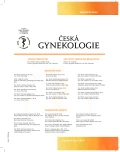Pregnancy outcomes in women with gestational diabetes: specific subgroups might require increased attention
Authors:
V. Bartáková 1; Veronika Ťápalová 2; K. Wágnerová 2; Petr Janků 2; J. Bělobrádková 3; K. Kaňková 1
Authors‘ workplace:
Ústav patologické fyziologie LF MU, Brno, přednostka ústavu prof. MUDr. A. Vašků, CSc.
1; Gynekologicko-porodnická klinika FN, Brno, přednosta kliniky prof. MUDr. P. Ventruba, DrSc., MBA
2; Interní gastroenterologická klinika FN, Brno, přednosta kliniky prof. MUDr. A. Hep, CSc.
3
Published in:
Ceska Gynekol 2017; 82(1): 16-23
Overview
Objectives:
To compare peri-partal parameters between two groups of pregnant women – with and without gestational diabetes mellitus (GDM), to correlate degree of glucose abnormality with incidence of peri-partal morbidity and, finally, to analyse the potential effect of comorbidities (i.e. obesity, hypertension, thyreopathy, polycystic ovary syndrome, trombophylia, anemia, allergy, smoking) on pregnancy outcomes.
Design:
Epidemiological observational „case-control“ study.
Setting:
Department of Obstetric and Gynaecology, Faculty Hospital Brno; Department of Internal Medicine, Diabetes Centre, Faculty Hospital Brno; Department of Pathophysiology, Faculty of Medicine, Masaryk University, Brno.
Methods:
The study comprised 432 pregnant women (364 with GDM diagnosis, 68 healthy controls) followed during a period 2011–2013. GDM was diagnosed by oral glucose tolerance test in 24–28th week of gestation (by fasting plasma glucose >5,6 mmol/l or >8,8 mmol/l in 60th min or >7,8 mmol/l in 120th min post-75g glucose load). Following peri-partal parameters were studied: ultrasonographic examination before delivery, a date of delivery, length of childbirth, induction, perinatal complications, post-delivery complications, section, abnormity in pH, base excess, Apgar score, birth weight.
Results:
Subjects with GDM had significantly increased rate of labour induction compared to healthy controls (P = 0.0035, chi-square test). Subgroup of GDM women classified as having a higher risk for adverse perinatal outcomes by a definition of Czech Obstetric and Gynaecology Society had significantly more labour inductions, more sections and instrumental deliveries. New-borns of those mothers had significantly more common worse perinatal outcomes (Apgar score and macrosomia).
Conclusion:
Based on our data risk stratification of GDM subjects according to Czech Obstetric and Gynaecology Society appears relevant and justified.
Keywords:
gestational diabetes mellitus, pregnancy, impaired glucose tolerance, perinatal morbidity
Sources
1. Al-Azemi, N., Diejomaoh, MF., Angelaki, E., Mohammed, AT. Clinical presentation and management of diabetes mellitus in pregnancy. Int J Womens Health, 2013, 6, p 1–10.
2. Anderlová, K., Krejčí, H., Klusáčková, P., et al. Alarmující výskyt gestačního diabetes mellitus při použití stávajících i nových mezinárodních diagnostických kritérií. Čes Gynek, 2014, 73, Praha: proLékaře.cz.
3. Andělová, K. Metformin v léčbě gestačního diabetu (GDM). Diabetol Metabol Endokrinol Výživa, 2014, 17(1), s. 8–11.
4. Andělová, K., Anderlová, K., Čechurová, D., et al. Gestační diabetes mellitus, Doporučený postup. Čes Gynek, 2015, 80.
5. Bartáková, V., Pleskačová, A., Kuricová, K., et al. Dysfunctional protection against advanced glycation due to thiamine metabolism abnormalities in gestational diabetes. Glycoconj J, 2016, 33(4), p. 591–598.
6. Buchanan, TA., Xiang, AH. Gestational diabetes mellitus. J Clin Invest, 2005, 115(3), p. 485–491.
7. Cheung, NW. The management of gestational diabetes. Vasc Health Risk Manag, 2009, 5(1), p. 153–164.
8. Corrado, F., Pintaudi, B., D‘Anna, R., et al. Perinatal outcome in a Caucasian population with gestational diabetes and preexisting diabetes first diagnosed in pregnancy. Diabetes Metab, 2015.
9. Ethridge, JK., Catalano, PM., Waters, TP. Perinatal outcomes associated with the diagnosis of gestational diabetes made by the international association of the diabetes and pregnancy study groups criteria. Obstet Gynecol, 2014, 124(3), p. 571–578.
10. Fadl, HE., Gärdefors, S., Hjertberg, R., et al. Randomized controlled study in pregnancy on treatment of marked hyperglycemia that is short of overt diabetes. Acta Obstet Gynecol Scand, 2015, 94(11), p. 1181–1187.
11. Group, HSCR. Hyperglycemia and Adverse Pregnancy Outcome (HAPO) Study: associations with neonatal anthropometrics. Diabetes, 2009, 58(2), p. 453–459.
12. Krejčí, H. Gestační diabetes mellitus. Postgrad Med, 2012, 3.
13. Laafira, A., White, SW., Griffin, CJ., Graham, D. Impact of the new IADPSG gestational diabetes diagnostic criteria on pregnancy outcomes in Western Australia. Aust N Z J Obstet Gynaecol, 2016, 56(1), p. 36–41.
14. Marshall, NE., Guild, C., Cheng, YW., et al. The effect of maternal body mass index on perinatal outcomes in women with diabetes. Am J Perinatol, 2014, 31(3), p. 249–256.
15. Metzger, BE., Gabbe, SG., Persson, B., et al. International association of diabetes and pregnancy study groups recommendations on the diagnosis and classification of hyperglycemia in pregnancy. Diabetes Care, 2010, 33(3), p. 676–682.
16. Metzger, BE., Lowe, LP., Dyer, AR., et al. Hyperglycemia and adverse pregnancy outcomes. N Engl J Med, 2008, 358(19), p. 1991–2002.
17. Nayak, PK., Mitra, S., Sahoo, JP., et al. Feto-maternal outcomes in women with and without gestational diabetes mellitus according to the International Association of Diabetes and Pregnancy Study Groups (IADPSG) diagnostic criteria. Diabetes Metab Syndr, 2013, 7(4), p. 206–209.
18. Organization WHO. World Health Organization. Definition, Diagnosis and Classification of Diabetes Mellitus and its Complications. Geneva: World Health Organization, 2013.
19. Roman, AS., Rebarber, A., Fox, NS., et al. The effect of maternal obesity on pregnancy outcomes in women with gestational diabetes. J Matern Fetal Neonatal Med, 2011, 24(5), p. 723–727.
20. Štembera, Z., Velebil, P. Rodička a novorozenec 2013. Praha: Ústav zdravotnických informací a statistiky ČR, 2015.
21. Zawiejska, A., Wender-Ozegowska, E., Radzicka, S., Brazert, J. Maternal hyperglycemia according to IADPSG criteria as a predictor of perinatal complications in women with gestational diabetes: a retrospective observational study. J Matern Fetal Neonatal Med, 2014, 27(15), p. 1526–1530.
Labels
Paediatric gynaecology Gynaecology and obstetrics Reproduction medicineArticle was published in
Czech Gynaecology

2017 Issue 1
Most read in this issue
-
Comparison of vaginal use of micronized progesterone for the luteal support.
Randomized study comparison of Utrogestan and Crinone 8% - Are risk factors in prenatal and perinatal period important for develompent of schizophrenia?
- Sheep as an experimental model in the reaserch of effects of pregnancy, delivery and surgical procedures on the pelvic floor
- Surgical treatment of the female stress urinary incontinence – from needles to mini-slings
